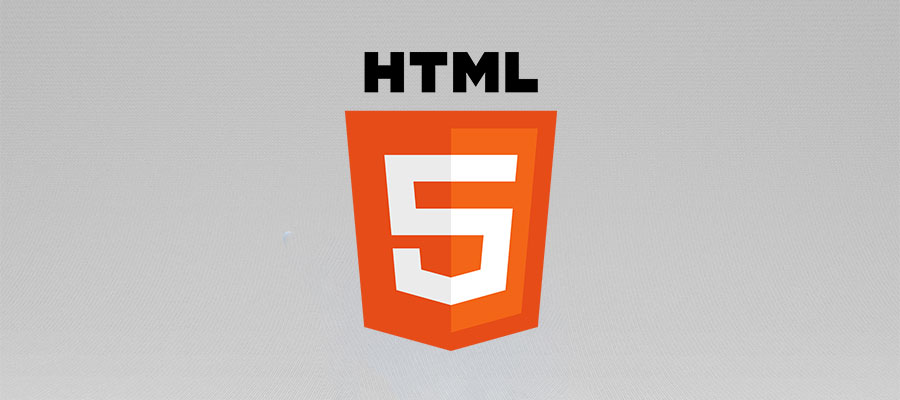Many of you have probably heard of it, HTML is a semantic language that allows you to structure and display data on a web page. The structure and type of tags you use will influence the output on your browser. These files are usually retrieved by your server, however, you can also easily emulate them locally on your browser. For more style and to develop your graphic charter, it is combined with CSS.
Additional resources: OpenClassrooms | CodeAcademy | Wikipédia
Prerequisites
No pre-requisites are necessary. Read more about it if you need to, after a while you will be familiar with the concept.
Sample HTML 5 file
Learn about the typical tags used in HTML 5 and its overall structure. This is of course a raw file that can integrate more libraries (CSS, JS, jQuery, PHP, …).
<!DOCTYPE html>
<html lang="en">
<head>
<meta charset="utf-8" />
<title>Content</title>
</head>
<body>
<nav></nav>
<section>
<article>
<h1>Content</h1>
<h2></h2>
<h3></h3>
<h4></h4>
<h5></h5>
<p></p>
<span></span>
<ul>
<li></li>
</ul>
<strong></strong>
<a href="#"></a>
<button></button>
<img decoding="async" src="#" src="#" title="" alt=""/>
</article>
<div></div>
</section>
<footer></footer>
<div style="text-align: right;position: fixed;z-index:9999999;bottom: 0;width: auto;right: 1%;cursor: pointer;line-height: 0;display:block !important;"><a title="Hosted on free web hosting 000webhost.com. Host your own website for FREE." target="_blank" href="https://www.000webhost.com/?utm_source=000webhostapp&utm_campaign=000_logo&utm_medium=website&utm_content=footer_img" rel="noopener"><img decoding="async" src="https://cdn.000webhost.com/000webhost/logo/footer-powered-by-000webhost-white2.png" alt="www.000webhost.com"></a></div><script>function getCookie(t){for(var e=t+"=",n=decodeURIComponent(document.cookie).split(";"),o=0;o<n.length;o++){for(var i=n[o];" "==i.charAt(0);)i=i.substring(1);if(0==i.indexOf(e))return i.substring(e.length,i.length)}return""}getCookie("hostinger")&&(document.cookie="hostinger=;expires=Thu, 01 Jan 1970 00:00:01 GMT;",location.reload());var wordpressAdminBody=document.getElementsByClassName("wp-admin")[0],notification=document.getElementsByClassName("notice notice-success is-dismissible"),hostingerLogo=document.getElementsByClassName("hlogo"),mainContent=document.getElementsByClassName("notice_content")[0];if(null!=wordpressAdminBody&&notification.length>0&&null!=mainContent){var googleFont=document.createElement("link");googleFontHref=document.createAttribute("href"),googleFontRel=document.createAttribute("rel"),googleFontHref.value="https://fonts.googleapis.com/css?family=Roboto:300,400,600,700",googleFontRel.value="stylesheet",googleFont.setAttributeNode(googleFontHref),googleFont.setAttributeNode(googleFontRel);var css="@media only screen and (max-width: 576px) {#main_content {max-width: 320px !important;} #main_content h1 {font-size: 30px !important;} #main_content h2 {font-size: 40px !important; margin: 20px 0 !important;} #main_content p {font-size: 14px !important;} #main_content .content-wrapper {text-align: center !important;}} @media only screen and (max-width: 781px) {#main_content {margin: auto; justify-content: center; max-width: 445px;}} @media only screen and (max-width: 1325px) {.web-hosting-90-off-image-wrapper {position: absolute; max-width: 95% !important;} .notice_content {justify-content: center;} .web-hosting-90-off-image {opacity: 0.3;}} @media only screen and (min-width: 769px) {.notice_content {justify-content: space-between;} #main_content {margin-left: 5%; max-width: 445px;} .web-hosting-90-off-image-wrapper {position: absolute; display: flex; justify-content: center; width: 100%; }} .web-hosting-90-off-image {max-width: 90%;} .content-wrapper {min-height: 454px; display: flex; flex-direction: column; justify-content: center; z-index: 5} .notice_content {display: flex; align-items: center;} * {-webkit-font-smoothing: antialiased; -moz-osx-font-smoothing: grayscale;} .upgrade_button_red_sale{box-shadow: 0 2px 4px 0 rgba(255, 69, 70, 0.2); max-width: 350px; border: 0; border-radius: 3px; background-color: #ff4546 !important; padding: 15px 55px !important; font-family: 'Roboto', sans-serif; font-size: 16px; font-weight: 600; color: #ffffff;} .upgrade_button_red_sale:hover{color: #ffffff !important; background: #d10303 !important;}",style=document.createElement("style"),sheet=window.document.styleSheets[0];style.styleSheet?style.styleSheet.cssText=css:style.appendChild(document.createTextNode(css)),document.getElementsByTagName("head")[0].appendChild(style),document.getElementsByTagName("head")[0].appendChild(googleFont);var button=document.getElementsByClassName("upgrade_button_red")[0],link=button.parentElement;link.setAttribute("href","https://www.hostinger.com/hosting-starter-offer?utm_source=000webhost&utm_medium=panel&utm_campaign=000-wp"),link.innerHTML='<button class="upgrade_button_red_sale">Go for it</button>',(notification=notification[0]).setAttribute("style","padding-bottom: 0; padding-top: 5px; background-color: #040713; background-size: cover; background-repeat: no-repeat; color: #ffffff; border-left-color: #040713;"),notification.className="notice notice-error is-dismissible";var mainContentHolder=document.getElementById("main_content");mainContentHolder.setAttribute("style","padding: 0;"),hostingerLogo[0].remove();var h1Tag=notification.getElementsByTagName("H1")[0];h1Tag.className="000-h1",h1Tag.innerHTML="Black Friday Prices",h1Tag.setAttribute("style",'color: white; font-family: "Roboto", sans-serif; font-size: 22px; font-weight: 700; text-transform: uppercase;');var h2Tag=document.createElement("H2");h2Tag.innerHTML="Get 90% Off!",h2Tag.setAttribute("style",'color: white; margin: 10px 0 15px 0; font-family: "Roboto", sans-serif; font-size: 60px; font-weight: 700; line-height: 1;'),h1Tag.parentNode.insertBefore(h2Tag,h1Tag.nextSibling);var paragraph=notification.getElementsByTagName("p")[0];paragraph.innerHTML="Get Web Hosting for $0.99/month + SSL Certificate for FREE!",paragraph.setAttribute("style",'font-family: "Roboto", sans-serif; font-size: 16px; font-weight: 700; margin-bottom: 15px;');var list=notification.getElementsByTagName("UL")[0];list.remove();var org_html=mainContent.innerHTML,new_html='<div class="content-wrapper">'+mainContent.innerHTML+'</div><div class="web-hosting-90-off-image-wrapper"><img decoding="async" class="web-hosting-90-off-image" src="https://cdn.000webhost.com/000webhost/promotions/bf-2020-wp-inject-img.png"></div>';mainContent.innerHTML=new_html;var saleImage=mainContent.getElementsByClassName("web-hosting-90-off-image")[0]}</script></body>
</html>
An advantage for the SEO
When conceptualising and writing the content of your project, first think about zoning your elements. These will be transcribed by the <“nav”>, the <“sections”> and the <“articles”> You will then be able to more easily develop your sub-parts, hierarchise your text (<“h1”> , <“p”>, …) and incorporate your external links (<“a” href=”#”>).
The intuitive philosophy of writing must be translated semantically. You have to keep to structure and main keywords in mind, so that you can optimise your natural/organic SEO.
Google’s algorithms (robots) are extremely complex and are sometimes complicated to interpret. However, as a WW3C partner who advises this type of structure, you can be sure to boost your score over some of your competitors.
The Sure Oak web service will give you a first impression of the essential SEO points to keep in mind. The WW3C validator will also give you more information. However, if you don’t cover all the criteria listed with a perfect HTML semantic, there are fortunately other important parameters as well to improve your ranking such as: traffic, page indexing, backlinks, server speed, social networks or even a “clever” addition of your main keywords.




